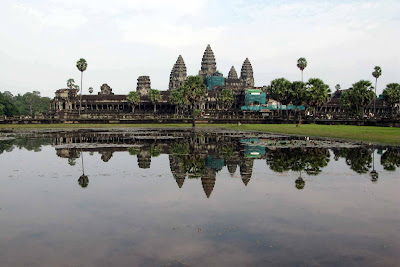
Three wonderful days in delightful Cambodia! The weather was perfect, the people are warm and engaging, visiting the markets was fun, the meals were delicious, and exploring the ruins and reconstructed ancient temples was magical! The temple and palace sites, which are everywhere under re-construction, seem to ignite primal and ancient memories.
Visitors climb, straddle stones, and crawl up steep stairs, through archways with none of the usual distance-back-behind-ropes-and- barricades.


Celestial Dancers
~ancient and contemporary~
Angkor Wat Temple

Celestial Dancers at Ta Som Temple


There are two 90-meter bas relief murals at Angkor Wat showing all the Hindu gods and their mythologies. Spectacular!




The temples in the region of Seam Reap, Cambodia were built first by the Hindu King Jayavarmun II who declared himself "Emperor of the World" early in the 9th century. Successive rulers over the next several centuries maintained power and continued building temples, tombs, palaces and public parade sites. Many of the temples, palaces, parade fields and arenas that are being reconstructed today were built by Suryavarman II (from c.1113 to 1150) and Jauavarman VII (from c.1181 to 1220).
Our Temples of Angkor tour visited Angkor Wat, Angkor Thom, Ta Prohm, Pre Rup, East Mebon, Ta Som, Keak Pean, and Prean Khan sites over 3 fabulous days.
By the 16th century, the Khmer rulers and people had largely converted to Buddhism and the capital had been moved to Phnom Penh.
Ta Prohm Temple


Pre Rup (cremation) Temple

 For some reason when I saw this Cambodian tee shirt "Dependent Vowels of the Khmer Letters" with the rest of the alphabet on the back side it completely tickled me! ...... anyway,
For some reason when I saw this Cambodian tee shirt "Dependent Vowels of the Khmer Letters" with the rest of the alphabet on the back side it completely tickled me! ...... anyway, the alphabet is lovely and rather flamboyant and the language is difficult to learn because it, like several of the Southeast Asian languages, is 'tonal.'






In Cambodia the women and the girls, even little girls, do the selling (and begging). They locate themselves in great numbers outside all the temples with postcards, local crafts and trinkets and just enough English to assault visitors, persuasively playing on sympathies. Often they say "I need money for school" but just as often this is right during school time.....
















All the warm Southeast Asian countries have also perfected the Night Markets, open to tourists until midnight after the temples and historic buildings have closed for the day. It is great fun bargaining for the already-inexpensive goods.




At a gas station, a spirit house, a sculpture, plants, and speakers.

Buddhism
Cambodia today is primarily Buddhist, though before the 16th century it was Hindu, and the Buddhism of today seems to be all-inclusive, incorporating some of the Hindu structure mythology into the temples, stories, and contemporary practice. Everywhere there are spirit houses outside homes and businesses, there are temples, and there are evidences of Buddhist practice.





Tonle Sap Lake floating villages





Cambodia has a huge central lake called Tonle Sap Lake where some Cambodians and many Vietnamese in separate movable locations have lived on boats for centuries. As the lake dries up seasonally the houseboats, stores, and schools move "to the outside" in the middle of the lake. As the lake fills up in the rainy season the villages move toward the edges, closer to the land. Boats carry visitors to the current locations; women and children beg for money "One dolla lay la" "One dolla lay la" while families harvest tiny fish in nets they beat behind their houses. The fish are used for bait, for fish meal, and for the many locations in the vicinity where these tiny fish eat the dead skin off of the feet of tourists (and others?) who pay by the 5-minutes. (I thought I would try this but the reality of fish eating off my feet - no doubt they would have had a feast - was too much for me when I got right up to the edge of the tanks!)



No comments:
Post a Comment